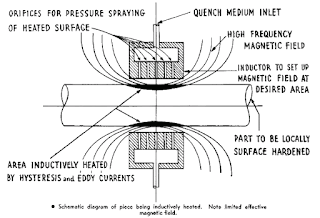Induction
Hardening is a type of heat treatment in which metal parts
are heated by electromagnetic induction and then quenched. It is also a type of
case hardening and can be used for many steel and steel alloys to improve
surface layer properties such as fatigue resistance and hardness.
Induction
Hardening Process
Induction Hardening can be split into two steps. The
first one is induction heating, in which electrically conducting metals are
heated with an electromagnet. The quenching phase follows directly after to
alter the surface structure of the material.
Induction
Heating
Materials such as steel are typically placed inside
a water cooled copper coil where they are subject to an alternating magnetic
field. They undergo electromagnetic induction by means of an electromagnet and
an electronic oscillator. This oscillator sends alternating currents through
the electromagnet, causing alternating magnetic fields that penetrate the
material. The results are eddy currents (loops of electrical current) which
heat the object within the coil. Induction hardening is a form of surface
hardening in which the depth can be up to 8mm. The deeper the currents
penetrate, the higher the frequency of the alternating magnetic fields have to
be Case
Hardening in Faridabad.
Steels that have a ferromagnetic structure (which is
inherited from the iron) can also be heated by magnetic hysteresis losses.
Magnetic hysteresis losses produce heat by re-aligning magnetic domains,
although it depends on the frequency of the currents, the penetration depth and
the properties of the material (size, density, alloys) how much heat can be
generated.
Quenching
Directly after the induction heating process, the
object has to be quenched, meaning that it has the be cooled down extremely
quickly. To do that, the workpiece is typically placed in a tank of oil or
water, although sometimes cold air is used. Quenching ensures that only the
surface is hardened and that heat doesn’t spread into the core of the material,
avoiding phase transformations from arising. Furthermore, the rapid cooling down
creates a martensitic or ferritic-martensitic structure on the surface layer.
These structure display higher tensile strength and low initial yielding stress
than a purely ferritic structure.
History
Induction heating was first developed and introduced
in its earliest form in 1831 by Michael Faraday. He could prove that an
electromotive force could be created by winding two copper coils around a
magnetic core while turning one of the windings on and off which affected the
other one. These currents were created by alternating magnetic fields around
the magnetic core. Because neither of the coils touch, the electromotive force
is induced into the second coil, the process was called induction heating.
Properties
that improve due to induction hardening
Deeper Case Depth: Induction hardening can penetrate
the surface of up to 0.31 inches (8 mm). This depends on the process of
induction hardening and the material’s properties.
Finer Grain Size: As mentioned above, induction
hardening changes the grain size on the surface of materials. A finer grain
size increases hardness because the surface is harder to penetrate.
Higher wear and fatigue resistance: Induction
hardening improves wear resistance because the structure of the surface layer
is altered. Ferritic steels obtain a martensitic structure which provides
improved wear resistance.
Induction
hardening in Faridabad is a good alternative to boronizing, which is a
type of surface hardening BorTec specializes in. Induction hardening is
recommended when only hardness should be improved. If you’re looking for a
treatment that can also improve adhesion, resistance against abrasive wear,
good stability at high temperatures and resistance against acids, the certified
BoroCoat treatment is the better choice. However, it depends on the area of
application and other factors which hardening technique is more suitable for
your needs.















